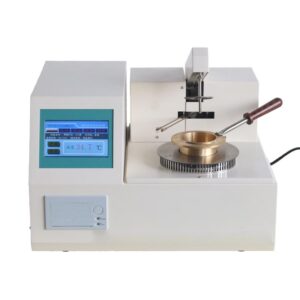How is the stability of reagents ensured in flash point tester?
Ensuring the stability of reagents in a flash point tester is critical for obtaining accurate and reliable test results.
Here are several measures commonly taken to maintain the stability of reagents:
- Proper Storage: Reagents used in flash point testing should be stored according to manufacturer specifications, typically in tightly sealed containers and away from sources of heat, light, moisture, and air. Proper storage conditions help prevent degradation or contamination of the reagents, which could affect their stability and performance.
- Regular Inspection: Reagents should be visually inspected regularly for signs of contamination, degradation, or other abnormalities. Any discoloration, precipitation, or changes in appearance may indicate deterioration and necessitate replacement of the reagent.
- Quality Control: Implementing a robust quality control program is essential for ensuring the stability and reliability of reagents. This may involve periodic testing of reagents using reference materials or standard samples to verify their performance and consistency.
- Expiration Dates: Reagents have limited shelf lives, and manufacturers typically provide expiration dates or recommended storage durations. It’s essential to adhere to these guidelines and replace expired reagents promptly to avoid using degraded or ineffective materials.
- Batch Tracking: Maintaining detailed records of reagent batches used in flash point testing allows for traceability and accountability. flash point tester By tracking the batch numbers and expiration dates of reagents, laboratories can quickly identify and address any issues related to stability or performance.
- Calibration: Calibrating the flash point tester regularly ensures accurate and reproducible measurements. Calibration procedures should include verification of reagent stability and performance, as deviations from expected results may indicate problems with reagent quality.
- Proper Handling: Reagents should be handled carefully to prevent contamination or degradation. This includes using clean and properly calibrated equipment, avoiding cross-contamination between reagent containers, and following recommended handling procedures outlined by the manufacturer.
- Manufacturer Recommendations: Following the manufacturer’s recommendations regarding reagent storage, handling, and usage is crucial for maintaining stability and ensuring the effectiveness of the flash point tester. Manufacturers often provide detailed instructions and guidelines specific to their products, which should be followed diligently.
By implementing these measures, laboratories can help ensure the stability of reagents used in flash point testing, thereby enhancing the accuracy, reliability, and consistency of test results. Regular monitoring, quality control, and adherence to best practices are essential for maintaining reagent stability and optimizing the performance of the flash point tester.
